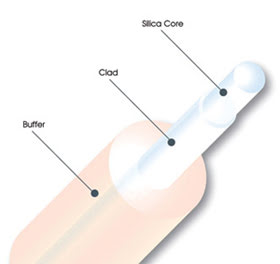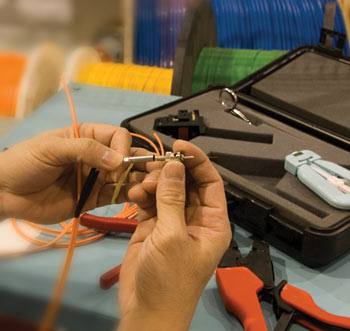Medical applications increasingly use fiber lasers to deliver light precisely where it’s needed.
Mick Speciale, OFS Optics
The term FTTx is shorthand for fiber to the x, with the x being a particular destination, such as the desk or the home. This term is taking on new meaning as optical fiber has extended into many new and challenging medical and surgical applications. One new x is light-based treatment systems for an increasingly diverse range of medical treatments.
Many medical applications now use high laser powers to deliver light to cut, coagulate or vaporize tissue. Although lasers long have been used in certain cosmetic procedures such as hair removal, their use has expanded into applications such as liposuction and the treatment of pigmented and vascular lesions.
Laser treatment works by directing a beam of light to a specific area within the body. For example, to treat varicose veins, energy from an 810-nm diode laser is delivered by optical fiber to the inside of the vein, where the laser energy collapses and shrinks the wall of the vein. The treatment is safe and effective because of the laser’s unique ability to treat the blood vessels of a vascular lesion selectively without adversely affecting the surrounding tissue. Thus, it eliminates many lesions while leaving the surrounding skin intact. This type of procedure is faster and less complex than conventional surgery. It has fewer side effects and requires shorter recovery periods.
Liposuction
In laser-assisted liposuction, energy from a pulsed Nd:YAG laser at 1064 nm helps to liquefy fat before it is removed. Lasers deliver energy to fat deposits below the skin, making the procedure less invasive than other forms of liposuction. Accurate laser power delivery also enables the surgeon to use the energy to sculpt the treated areas, leaving the skin smooth and more natural looking.
These and related procedures have become more common in recent years in part because of advances in optical fiber technology.

Figure 1. A standard optical fiber construction is illustrated with core/clad/buffer layers. In this example, the fiber cladding functions as part of the lightguide.
Optical fiber is composed of a silica glass core, which is surrounded by a cladding layer that guides the light waves and prevents light from leaking out of the core (Figure 1). Surrounding the cladding is a coating that also can serve as a secondary cladding to contain light within the fiber. Varying the properties of these components -- such as core composition and diameter, cladding composition and coating material -- produces fibers that are best-suited to specific applications.
The chemical composition of the core is changed through the use of various dopants such as erbium and germanium -- singly or in combination -- to control transmission properties by changing the numerical aperture of the core. Applications such as treatment of vascular lesions and laser-assisted liposuction require fiber with a high numerical aperture, which essentially is the light-gathering attribute of a fiber that enables more input power.
Another desirable property of optical fiber used in these and similar applications is the ability to handle higher laser power, even when the fiber is bent during the course of the medical procedure.
Fiber can sustain damage either when energy escapes from the core into the cladding or when energy that has been contained in the cladding affects the coating. The coating can be optimized in such a way as to reduce the amount of laser energy that it absorbs. This in turn reduces the stress on the entire fiber assembly and enables higher transmission of laser energy, even under tight bends. The end result of this has been systems that safely and reliably deliver more powerful laser light with greater precision.

Figure 2. The fiber shown is terminated with a connector.
In addition to selecting specific specialty fibers for these applications, laser treatments also are enhanced by advances in the assembly of system components that provide greater accuracy and durability. Fiber must be terminated to an appropriate connector, a process made more efficient by the use of high-resolution cameras and monitors, along with specialized cleaving tools that contribute to the overall quality of the assembly (Figure 2). Because the optical fiber components of laser treatment systems are replaceable, high-quality assemblies with a high degree of repeatability are critical to maintaining patient care and to controlling costs.
Meet the author
Mick Speciale is a medical market manager for OFS Specialty Photonics Div. in Avon, Conn.; e-mail: [email protected].